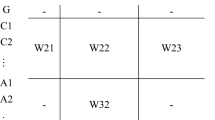Abstract
The Analytic Network Process (ANP) is a multicriteria theory of measurement used to derive relative priority scales of absolute numbers from individual judgments (or from actual measurements normalized to a relative form) that also belong to a fundamental scale of absolute numbers. These judgments represent the relative influence, of one of two elements over the other in a pairwise comparison process on a third element in the system, with respect to an underlying control criterion. Through its supermatrix, whose entries are themselves matrices of column priorities, the ANP synthesizes the outcome of dependence and feedback within and between clusters of elements. The Analytic Hierarchy Process (AHP) with its independence assumptions on upper levels from lower levels and the independence of the elements in a level is a special case of the ANP. The ANP is an essential tool for articulating our understanding of a decision problem. One had to overcome the limitation of linear hierarchic structures and their mathematical consequences. This part on the ANP summarizes and illustrates the basic concepts of the ANP and shows how informed intuitive judgments can lead to real life answers that are matched by actual measurements in the real world (for example, relative dollar values) as illustrated in market share examples that rely on judgments and not on numerical data.
Similar content being viewed by others
References
Blair, A.R., R. Nachtmann, R. Whitaker and T.L. Saaty, “Forecasting the resurgence of the US economy in 2001: An expert judgment approach”, Socio-Economic Planning Sciences, Vol. 36, No.2, pp77–91, 2002.
Horn, R.A. and C.R. Johnson, Matrix Analysis, Cambridge University Press, New York, 1985.
Saaty, T.L., “Presidential elections, the superconducting supercollider, and organ transplant decisions”, pp345 in Multiple Criteria Decision Making, edited by A. Goicoechea, L. Duckstein, and S. Zionts, Springer-Verlag, 1992.
Saaty, T.L., and D.S. Turner, “Prediction of the 1996 super bowl”, Proceedings of the Fourth International Symposium on the Analytic Hierarchy Process, Simon Fraser University, Burnaby, B.C., Canada, July 12–15, 1996.
Saaty, T.L., and L. G. Vargas, Models, Methods, Concepts and Applications of the Analytic Hierarchy Process, Kluwer Academic Publishers, Boston, 2000.
Saaty, T.L., “Decision making — the Analytic Hierarchy and Network Processes (AHP/ANP)”, Journal of Systems Science and Systems Engineering, Vol. 13, No. 1, pp1–35, 2004a.
Saaty, T.L., The Analytic Network Process: Decision Making with Dependence and Feedback, RWS Publications, 4922 Ellsworth Ave., Pittsburgh, PA 15213, 1996, completely revised and published 2001, completely revised 2004b.
SuperDecisions Software: www.superdecisions.com A program that is free to download and use for several months. For more information contact Creative Decisions Foundation, or email rozann@creativedecisions.net.
Author information
Authors and Affiliations
Additional information
Thomas L. Saaty holds the Chair of University Professor, Katz Graduate School of Business, University of Pittsburgh, Pittsburgh, PA, and obtained his Ph.D. in mathematics from Yale University. Before that he was a professor at the Wharton School of the University of Pennsylvania for ten years. Prior to that he spent seven years at the Arms Control and Disarmament Agency in the State Department in Washington, DC, that carried out the arms reduction negotiations with the Soviets in Geneva. His current research interests include decision-making, planning, conflict resolution and synthesis in the brain. As a result of his search for an effective means to deal with weapons tradeoffs at the Disarmament Agency and, more generally, with decision-making and resource allocation, Professor Saaty developed The Analytic Hierarchy Process (AHP) and its generalization to dependence and feedback, the Analytic Network Process (ANP). He is co-developer of the software Expert Choice and of the software Super Decisions for decisions with dependence and feedback. He has authored or co-authored twelve books on the AHP/ANP. Professor Saaty has also written a number of other books that embrace a variety of topics, including Modern Nonlinear Equations, Nonlinear Mathematics, Graph Theory, The Four Color Problem, Behavioral Mathematics, Queuing Theory, Optimization in Integers, Embracing the Future and The Brain: Unraveling the Mystery of How It Works. His most recent book is Creative Thinking, Problem Solving & Decision Making. The book is a rich collection of ideas, incorporating research by a growing body of researchers and practitioners, profiles of creative people, projects and products, theory, philosophy, physics and metaphysics...all explained with a liberal dose of humor. He has published more than 300 refereed articles in a wide variety of professional journals. He has been on the editorial boards of Mathematical Reviews, Operations Research, Naval Research Logistics Quarterly, Mathematical and Computer Modeling, Socio-Economic Planning Sciences, Applied Mathematics Letters, and several others. He also served as consultant to many corporations and governments.
Rights and permissions
About this article
Cite this article
Saaty, T.L. Fundamentals of the analytic network process — Dependence and feedback in decision-making with a single network. J. Syst. Sci. Syst. Eng. 13, 129–157 (2004). https://doi.org/10.1007/s11518-006-0158-y
Issue Date:
DOI: https://doi.org/10.1007/s11518-006-0158-y




